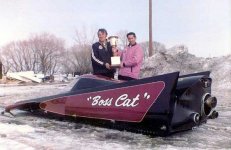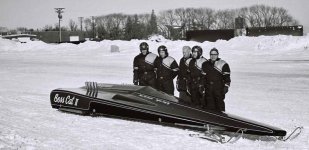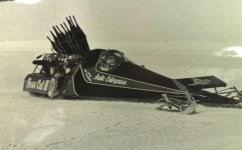-
There were many reasons for the change of the site software, the biggest was security. The age of the old software also meant no server updates for certain programs. There are many benefits to the new software, one of the biggest is the mobile functionality. Ill fix up some stuff in the coming days, we'll also try to get some of the old addons back or the data imported back into the site like the garage. To create a thread or to reply with a post is basically the same as it was in the prior software. The default style of the site is light colored, but i temporarily added a darker colored style, to change you can find a link at the bottom of the site.
You are using an out of date browser. It may not display this or other websites correctly.
You should upgrade or use an alternative browser.
You should upgrade or use an alternative browser.
Can-Am Spyder Turbo Concept- NASCAR Inspired
- Thread starter Lamonster
- Start date
Bob Denman
New member
Those were the Boss Cats: They built 3 of themNever got to see that one, but saw and got to ride a 795 TX Polaris triple. Can't remember the name of it but one year Artic Cat had a sled that looked like a drag race car with tracks on each side and skis in front at the Spokane auto boat, speed show.
.
The first one was turbine powered, and blew up! :yikes:
Boss Cat II had a v-8 under the bodywork, and was retired after reaching 180 mph... :bowdown:
Boss Cat III was a handling nightmare: they gave up on it after about 137 mph... :banghead:
(Multiple snowmobile engines)
Attachments
Dennis in Lodi
Member
also heard the same thing
Simply put, Ski Doo snowmobiles have stiff competion in the in the performance catagory. Although the 1330 motor does not appear to directly cross into their sled line, current top performance Ski Doo sleds are getting 140 plus hp on a triple platform.
Keep in mind that the Suzuki Hyabusa is a 1330 cc motor with the same shim and bucket valve set up that gets 175 hp without a turbo.
My plan all along was to wait for a good deal on a used 1330 f3. I figured by time this happens the aftermarket would have the 1330 platform over a 140hp. But the simple math is I would probably have more invested in that project vs. buying a factory F3 turbo project new.
I'm all in on buying a new one. But I must keep quiet so my wife can't hear me typing.
Simply put, Ski Doo snowmobiles have stiff competion in the in the performance catagory. Although the 1330 motor does not appear to directly cross into their sled line, current top performance Ski Doo sleds are getting 140 plus hp on a triple platform.
Keep in mind that the Suzuki Hyabusa is a 1330 cc motor with the same shim and bucket valve set up that gets 175 hp without a turbo.
My plan all along was to wait for a good deal on a used 1330 f3. I figured by time this happens the aftermarket would have the 1330 platform over a 140hp. But the simple math is I would probably have more invested in that project vs. buying a factory F3 turbo project new.
I'm all in on buying a new one. But I must keep quiet so my wife can't hear me typing.
....Shortly after the 1330 Ace engine release I had a conversation with someone familiar with the development. He said there was 150 HP there ...NORMALLY ..aspirated without any strain to the current components. So I think the TURBO is purely for the FLASH......Now if they " TURBOED " that :yikes: :clap: :clap: :clap: :yes: :yes: :yes:......................Mike :thumbup:
BLUEKNIGHT911
Sadly Passed Oct 2024 - RIP
SLIGHTLY USED F-3
.Dennis, there's one on E-bay right now 2015 for $16,000..........Mike :thumbup:Simply put, Ski Doo snowmobiles have stiff competion in the in the performance catagory. Although the 1330 motor does not appear to directly cross into their sled line, current top performance Ski Doo sleds are getting 140 plus hp on a triple platform.
Keep in mind that the Suzuki Hyabusa is a 1330 cc motor with the same shim and bucket valve set up that gets 175 hp without a turbo.
My plan all along was to wait for a good deal on a used 1330 f3. I figured by time this happens the aftermarket would have the 1330 platform over a 140hp. But the simple math is I would probably have more invested in that project vs. buying a factory F3 turbo project new.
I'm all in on buying a new one. But I must keep quiet so my wife can't hear me typing.
Mike Ard
New member
Those were the Boss Cats: They built 3 of them
The first one was turbine powered, and blew up! :yikes:

Boss Cat II had a v-8 under the bodywork, and was retired after reaching 180 mph... :bowdown:

Boss Cat III was a handling nightmare: they gave up on it after about 137 mph... :banghead:
(Multiple snowmobile engines)

It it was the Boss Cat ll that I saw in Spokane. Man what a sled!!
I agree, nothing "special" about 150hp I'm actually surprised they did a turbo to get there. I kinda believe that it's all for show because "turbo" sounds cool!
Seems like it would be plenty easy to get 150hp out of a 1330cc NA triple. That is what the RT/F3 should be STOCK. :2thumbs:
BRP, you have all those Rotax triple 1503 supercharged motors making 260+hp. Had them in production since late 2003/2004 in the skis. What gives?! :dontknow:
Most of the supercharged 215 & 260 hp Sea-Doo's have about a 150 hour engine life before they self destruct...(even with the supercharger rebuilt at 100 hrs.) They are fast while they last...
True, but that 150 hours is also running the majority of its life at 8k rpms, mostly full throttle runs, and in a marine environment. Probably not running it like that in a street bike platform so you'd think it would last a lot longer?Most of the supercharged 215 & 260 hp Sea-Doo's have about a 150 hour engine life before they self destruct...(even with the supercharger rebuilt at 100 hrs.) They are fast while they last...
Sent from my Nexus 6 using Tapatalk
Last edited:
Bob Denman
New member
It would last longer.... except BRP is building their street engines to last FARRRRR longer. :2thumbs:
Spyderjockey has over 115,000 miles on his 2008 GS so far: the engine is STILL running like it did, when it was new!
Spyderjockey has over 115,000 miles on his 2008 GS so far: the engine is STILL running like it did, when it was new!
Dennis in Lodi
Member
Good reliability in all high performance production motorcycles
Having been close to this circle of performance vs. longevity I would like to add this.
I spent $10K on building a cycle motor. Titanium eveything, blah, blah, blah. It lasted only FOUR hours in ROAD testing and never made it to the track.
I could have bought a larger cc production cycle for 1/2 of what I had into my project and had the same hp. Manufacturuers have a vested interested in reliability and are best equiped to engineer a complete package.
The problem in engines that work on water is simple. Water does not compress if it enters a combustion chamber.
The only known issue I know of in manufactured performance cycles is Ducati refused to get off it's PUSH ROD platform to get performance. I believe they addressed that horse and buggy thought process.
Having been close to this circle of performance vs. longevity I would like to add this.
I spent $10K on building a cycle motor. Titanium eveything, blah, blah, blah. It lasted only FOUR hours in ROAD testing and never made it to the track.
I could have bought a larger cc production cycle for 1/2 of what I had into my project and had the same hp. Manufacturuers have a vested interested in reliability and are best equiped to engineer a complete package.
The problem in engines that work on water is simple. Water does not compress if it enters a combustion chamber.
The only known issue I know of in manufactured performance cycles is Ducati refused to get off it's PUSH ROD platform to get performance. I believe they addressed that horse and buggy thought process.
True, but that 150 hours is also running the majority of its life at 8k rpms, mostly full throttle runs, and in a marine environment. Probably not running it like that in a street bike platform so you'd think it would last a lot longer?
Sent from my Nexus 6 using Tapatalk
Bob Denman
New member
While I agree with you: I took a 432cc, 65 horse snowmobile engine; and turned it into a 513cc , 107 horse "lake-shortener". :thumbup:
I built it back in 1992, and it still runs today. We had one burn-down, when an e-clip broke in half, and dropped the jet needle. (A 15 cent part cost me $4000! :gaah
When I built it; I didn't push any boundaries, and left lots of room for reliability.
(We stroked it by 3mm, and added the jug off of a 488 F.I. engine to the mix...)
Will it last as long as a stock sled motor? :dontknow: It exceeded my expectations exponentially!
But I'm not a manufacturer, with a warranty issue lurking... :shocked:
I built it back in 1992, and it still runs today. We had one burn-down, when an e-clip broke in half, and dropped the jet needle. (A 15 cent part cost me $4000! :gaah
When I built it; I didn't push any boundaries, and left lots of room for reliability.
(We stroked it by 3mm, and added the jug off of a 488 F.I. engine to the mix...)
Will it last as long as a stock sled motor? :dontknow: It exceeded my expectations exponentially!
But I'm not a manufacturer, with a warranty issue lurking... :shocked:
Last edited:
Fat Baxter
Member
Personally, I'd pass on anything with a turbo. Turbos run on hot exhaust, and heat is the enemy of the internal combustion engine. Plus, they run at very high RPMs, and thus are highly stressed. When they fail, they dump parts into the top end of the engine, requiring (in addition to a new turbo), an entire top end replacement. IMO, they are not a wise investment for the long run.
If you lease cars, for example, and turn them over every few years, you'll likely never see a turbo failure. But if you're like me and hang on to your vehicles for 10+ years, the odds of a catastrophic turbo failure go up.
Here's a related auto discussion thread.
Many auto manufactureres are moving to small turbo engines because in many overseas markets, cars are taxed according to engine displacement. Hence the move to smaller engines, with turbos to make up for the loss of power. But I think many of the manufacturers have set themselves up for problems in the out-years.
If you lease cars, for example, and turn them over every few years, you'll likely never see a turbo failure. But if you're like me and hang on to your vehicles for 10+ years, the odds of a catastrophic turbo failure go up.
Here's a related auto discussion thread.
Many auto manufactureres are moving to small turbo engines because in many overseas markets, cars are taxed according to engine displacement. Hence the move to smaller engines, with turbos to make up for the loss of power. But I think many of the manufacturers have set themselves up for problems in the out-years.
Wildrice
New member
10 PSI with stock rods/pistons without a head spacer might be pushing it. I'd be guessing closer to 6-8 psi on premium fuel. but if it worked/lasted I would spend the money on my 2015 F3's providing the total cost of turbo & installation didn't exceed a significant price increase from a factory warranty version. I've blown 2 hayabusa engines land speed racing + a street Harley with performance rods/pistons/cam ported exhaust. I'm not a Harley fan anyway but the 1298cc busa was a strong engine...Good question, I would guess 8-10lbs:dontknow:
Nothing like the engine letting go at 193-196 mph--usually the valve seats melted out of the aluminum heads..........I needed to back out 4 degrees timing on the top end.....& I was using C-16 117 octane fuel....
Last edited:
Bob Denman
New member
Personally, I'd pass on anything with a turbo. Turbos run on hot exhaust, and heat is the enemy of the internal combustion engine. Plus, they run at very high RPMs, and thus are highly stressed. When they fail, they dump parts into the top end of the engine, requiring (in addition to a new turbo), an entire top end replacement. IMO, they are not a wise investment for the long run.
If you lease cars, for example, and turn them over every few years, you'll likely never see a turbo failure. But if you're like me and hang on to your vehicles for 10+ years, the odds of a catastrophic turbo failure go up.
Here's a related auto discussion thread.
Many auto manufactureres are moving to small turbo engines because in many overseas markets, cars are taxed according to engine displacement. Hence the move to smaller engines, with turbos to make up for the loss of power. But I think many of the manufacturers have set themselves up for problems in the out-years.
Technology has come a long ways... The 1980s have been gone for a long time now. These new turbo setups are pretty lightly-stressed, and will last for a VERY long time. :thumbup:
(Not like the old Ford 4-cylinder turbos, that were done at about 80,000 miles...)
That's a nice way to say it. I had it all typed out but deleted it. I'm trying to turn over a new leaf and play nice...[emoji38]Technology has come a long ways... The 1980s have been gone for a long time now. These new turbo setups are pretty lightly-stressed, and will last for a VERY long time.[emoji106](Not like the old Ford 4-cylinder turbos, that were done at about 80,000 miles...)
The benefits of a modern day turbo setup far exceed what could ever be done 25+ years ago, and that includes most NA motors too. Its the way of the future.
Sent from my Nexus 6 using Tapatalk
Bob Denman
New member
Just stop...I'm NOT gonna say that we were thinking alike, because I'd hate to insult you like that! :roflblack: :2thumbs:
Sent from my Nexus 6 using Tapatalk
crazycanuck
New member
That's a nice way to say it. I had it all typed out but deleted it. I'm trying to turn over a new leaf and play nice...[emoji38]
The benefits of a modern day turbo setup far exceed what could ever be done 25+ years ago, and that includes most NA motors too. Its the way of the future.
Sent from my Nexus 6 using Tapatalk
Always bring your A game, no deletions required
Similar threads
- Replies
- 5
- Views
- 2K
- Replies
- 26
- Views
- 6K
- Replies
- 12
- Views
- 3K



